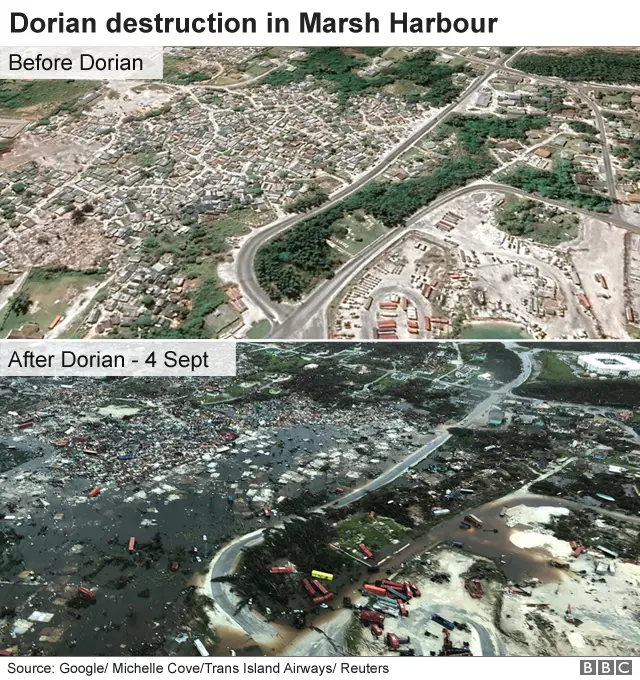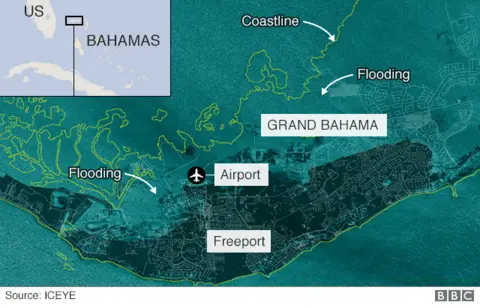Hurricane Dorian: Scale of Bahamas devastation emerges
Rescuers have begun to reach areas of the northern Bahamas devastated by Hurricane Dorian, with aerial images showing a trail of destruction.
PM Hubert Minnis said some areas had been "decimated" as the death toll rose to at least 20.
The hurricane made landfall on 1 September and battered the Abaco Islands and Grand Bahama, in the north of the archipelago, for two days.
Dorian has moved off north and still threatens the eastern US seaboard.
Forecasters have warned it could make landfall on the coast of South or North Carolina on Thursday.
Although the hurricane has weakened to a category two storm with maximum sustained winds of 105mph (165km/h), it has grown larger in area.
What is the damage to the Abacos and Grand Bahama?
Mr Minnis said the Bahamas was facing "one of the greatest national crises in our country's history".
Late on Wednesday, the country's health minister, Duane Sands, confirmed that the death toll had risen from seven to at least 20.


Lia Head-Rigby, who runs a relief group and overflew the Abacos, previously said her representatives had told her there were "a lot more dead".
"It's total devastation. It's decimated. Apocalyptic," she told the Associated Press (AP) news agency.
Aerial images over the Abacos, including the port town of Marsh Harbour, showed mile upon mile of destruction, with roofs torn off, scattered debris, overturned cars, shipping containers and boats, and high water levels.
"There's nothing left in most of Marsh Harbour," said Alicia Cook, who evacuated from the area. "People are starting to panic: pillaging, looting... it's just no way everyone's going to get out."
Bob Cornea also spoke to the BBC in the capital Nassau after being evacuated from Marsh Harbour. He said he and his wife took shelter on the second storey of their son's house.
"Water was up to my neck. It stayed like that for two or three hours... My son... he got us out and we got over to safety.
"We've been through all kinds of hurricanes, all kinds of storms: never anything that bad. I mean, it was like we were standing in the middle of the ocean. That's what it looked like. Waves, the water just crashing in over us. Horrifying. Absolutely horrifying."
Opposition leader Philip Brave Davis described the scenes from a flight over the islands as a "horrible sight".
Parts of the Bahamas received up to 35in (89cm) of rain.
The situation on Grand Bahama is less clear, as Dorian only moved on late on Tuesday after nearly two days of pummelling, cutting many communication lines.
Most rescue work was being done on an ad hoc basis by locals using boats and jet skis, but it was being hampered by flooded roads, fallen trees and submerged debris.
Rescue teams were "beginning to get on the ground", National Security Minister Marvin Dames said on Wednesday, according to AP.
Mr Minnis said: "Our priority at this time is search, rescue and recovery. It will take all of us as a caring community - government, church, businesses and individuals - to help restore the lives of our people."
People have taken to social media to post lists of those they have lost contact with during the storm.
The International Red Cross fears 45% of homes on Grand Bahama and the Abacos - some 13,000 properties - have been severely damaged or destroyed.
Some 60,000 people will need food aid and clean water, UN officials say.
A map from the Finnish satellite company ICEYE showed the extent of the flooding on Grand Bahama:

Will Dorian hit the US?
At 18:00 GMT, the National Hurricane Center said Dorian was located about 115 miles (185km) east of Jacksonville in Florida and about 180 miles south of Charleston, South Carolina.


The storm - moving at 9mph (15km/h) - would travel parallel to the Florida and Georgia coasts through Wednesday night, then "near or over" the coasts of the Carolinas through Thursday and Friday, it said.
The NHC warned there was a danger of life-threatening storm surges for coastal communities north of Port Canaveral in Florida all the way to the North Carolina-Virginia border.
Dorian is expected to weaken over the next few days but will remain a powerful hurricane.
Is climate change making hurricanes worse?
Scientists cannot say whether climate change is increasing the number of hurricanes, but the ones that do happen are likely to be more powerful and more destructive because of our warming climate, says BBC Weather's Tomasz Schafernaker.
Here's why:
- An increase in sea surface temperatures strengthens the wind speeds within storms and also raises the amount of precipitation a hurricane will dump
- Sea levels are expected to increase by one to four feet over the next century, bringing the potential of far worse damage from sea surges and coastal flooding during storms

Use our guide to see how these deadly storms form, their devastating effects and how they are measured:


How have you been affected by Hurricane Dorian? Share your experiences by emailing [email protected].
Please include a contact number if you are willing to speak to a BBC journalist. You can also contact us in the following ways:
- WhatsApp: +44 7756 165803
- Tweet: @BBC_HaveYourSay
- Send pictures/video to [email protected]
- Upload your pictures / video here
- Text an SMS or MMS to 61124 or +44 7624 800 100
- Please read our terms of use and privacy policy
